Business Strategy Analysis: The State of Autonomous Transport and UBER
VerifiedAdded on 2022/12/28
|20
|5386
|1
Report
AI Summary
This report provides a detailed analysis of UBER's business strategy, focusing on its approach to autonomous transport. It begins with an introduction to the macro environment and applies PESTLE analysis to assess the external factors influencing UBER. The report then delves into the internal environment, utilizing the VRIO framework and McKinsey's 7S model to evaluate UBER's capabilities and resources. Porter's Five Forces model is applied to assess the competitive landscape. The report also examines the application of the Ansoff Matrix, SWOT analysis, and other strategic management tools to UBER's strategic planning, culminating in the development of a strategic management plan with priorities and objectives. The report concludes with a summary of findings and includes a comprehensive list of references.
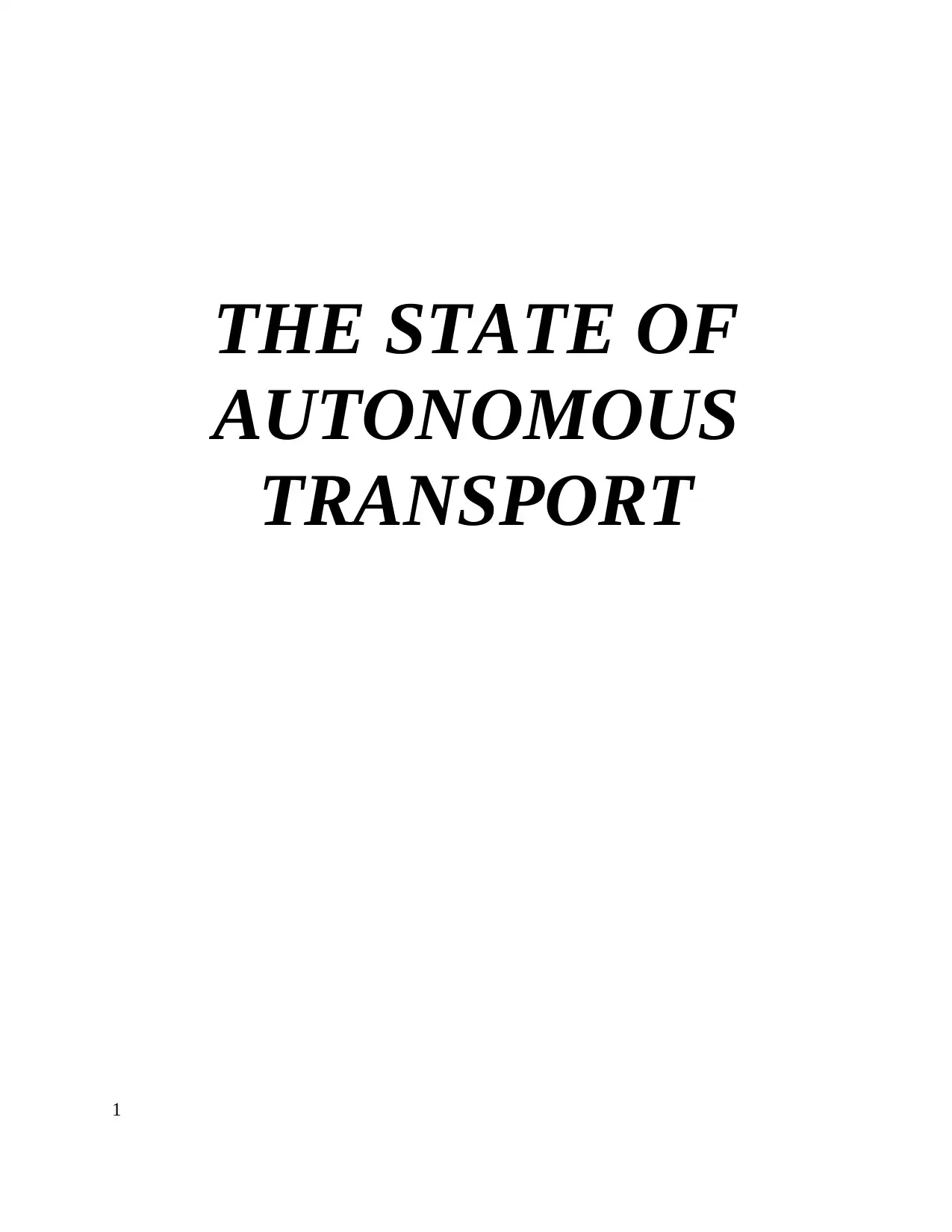
THE STATE OF
AUTONOMOUS
TRANSPORT
1
AUTONOMOUS
TRANSPORT
1
Paraphrase This Document
Need a fresh take? Get an instant paraphrase of this document with our AI Paraphraser
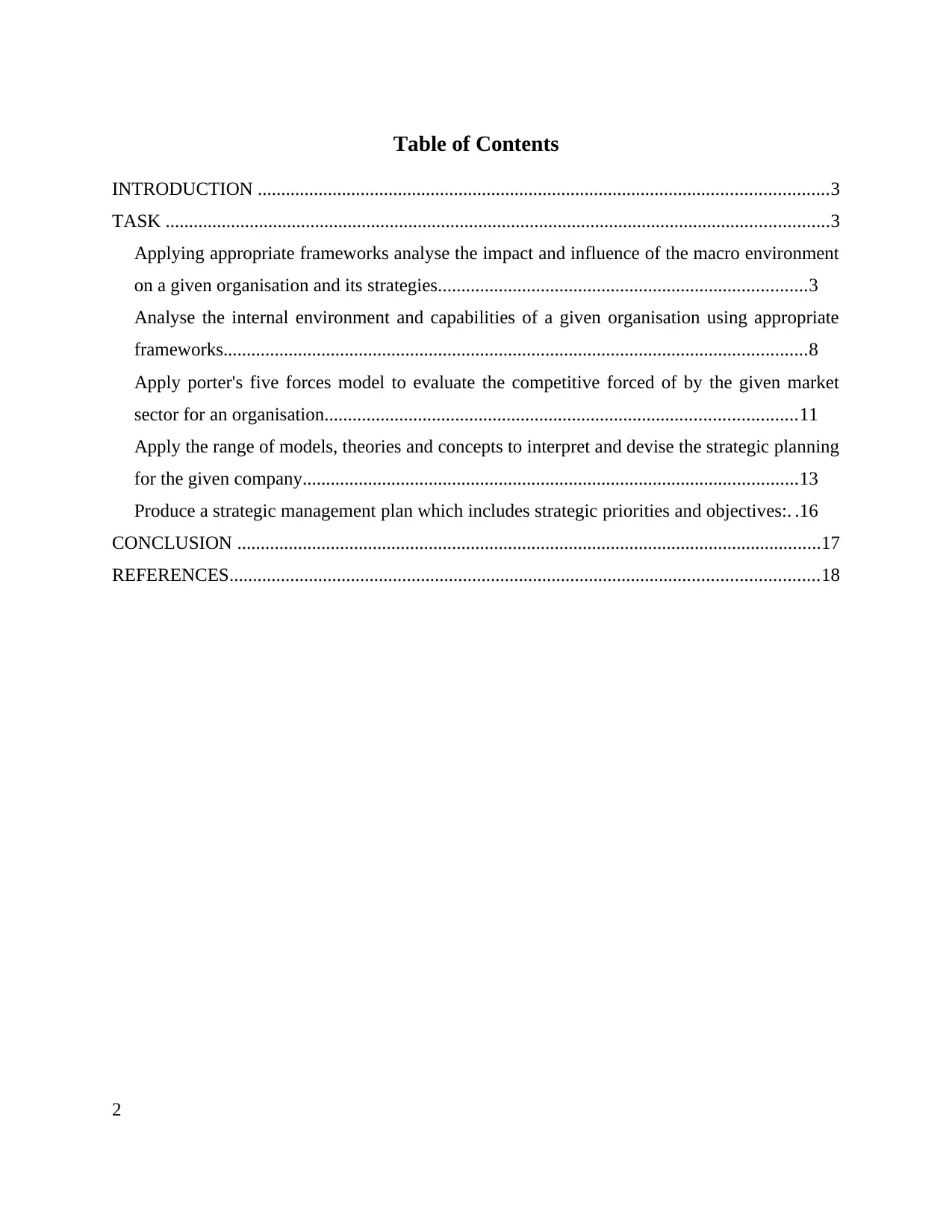
Table of Contents
INTRODUCTION ..........................................................................................................................3
TASK ..............................................................................................................................................3
Applying appropriate frameworks analyse the impact and influence of the macro environment
on a given organisation and its strategies...............................................................................3
Analyse the internal environment and capabilities of a given organisation using appropriate
frameworks.............................................................................................................................8
Apply porter's five forces model to evaluate the competitive forced of by the given market
sector for an organisation.....................................................................................................11
Apply the range of models, theories and concepts to interpret and devise the strategic planning
for the given company..........................................................................................................13
Produce a strategic management plan which includes strategic priorities and objectives:. .16
CONCLUSION .............................................................................................................................17
REFERENCES..............................................................................................................................18
2
INTRODUCTION ..........................................................................................................................3
TASK ..............................................................................................................................................3
Applying appropriate frameworks analyse the impact and influence of the macro environment
on a given organisation and its strategies...............................................................................3
Analyse the internal environment and capabilities of a given organisation using appropriate
frameworks.............................................................................................................................8
Apply porter's five forces model to evaluate the competitive forced of by the given market
sector for an organisation.....................................................................................................11
Apply the range of models, theories and concepts to interpret and devise the strategic planning
for the given company..........................................................................................................13
Produce a strategic management plan which includes strategic priorities and objectives:. .16
CONCLUSION .............................................................................................................................17
REFERENCES..............................................................................................................................18
2
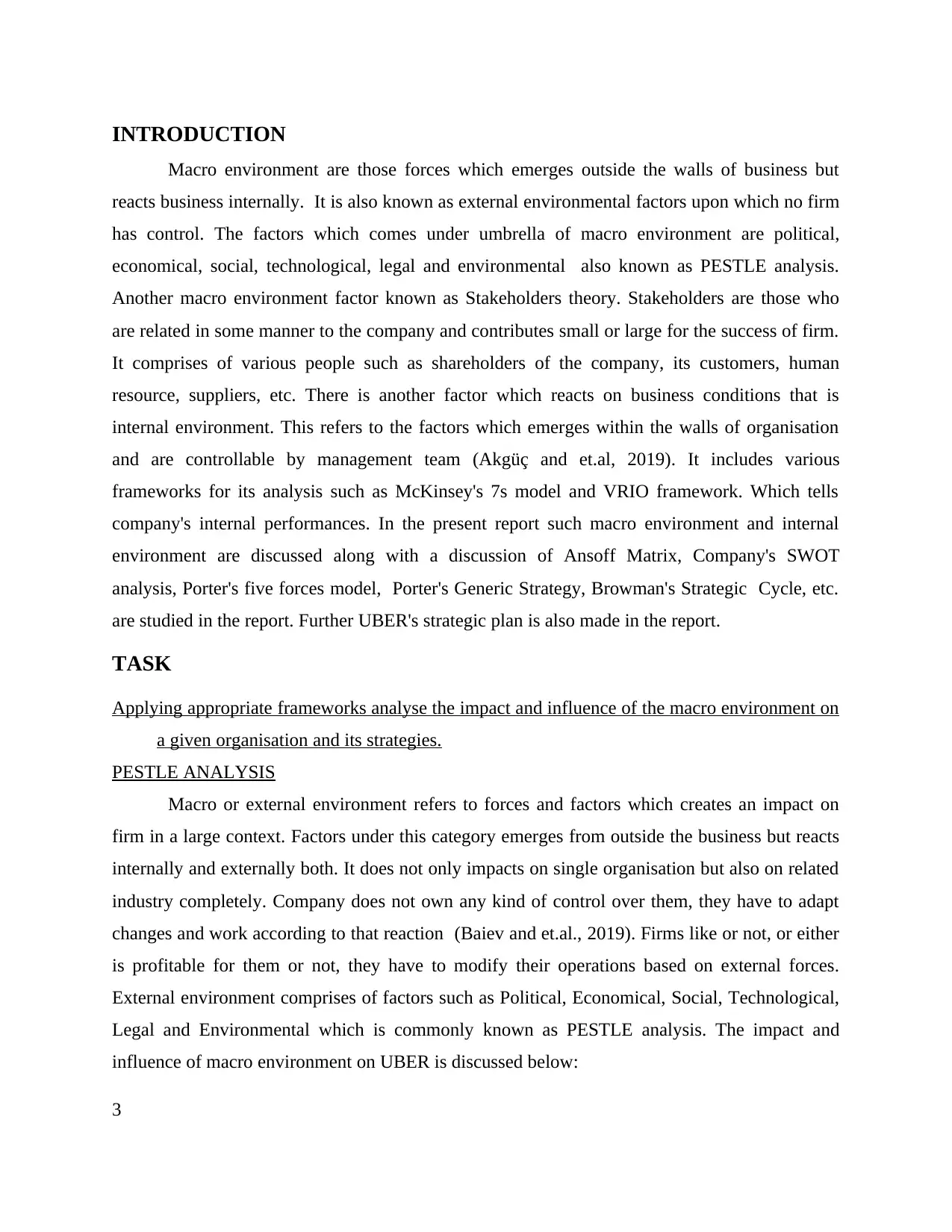
INTRODUCTION
Macro environment are those forces which emerges outside the walls of business but
reacts business internally. It is also known as external environmental factors upon which no firm
has control. The factors which comes under umbrella of macro environment are political,
economical, social, technological, legal and environmental also known as PESTLE analysis.
Another macro environment factor known as Stakeholders theory. Stakeholders are those who
are related in some manner to the company and contributes small or large for the success of firm.
It comprises of various people such as shareholders of the company, its customers, human
resource, suppliers, etc. There is another factor which reacts on business conditions that is
internal environment. This refers to the factors which emerges within the walls of organisation
and are controllable by management team (Akgüç and et.al, 2019). It includes various
frameworks for its analysis such as McKinsey's 7s model and VRIO framework. Which tells
company's internal performances. In the present report such macro environment and internal
environment are discussed along with a discussion of Ansoff Matrix, Company's SWOT
analysis, Porter's five forces model, Porter's Generic Strategy, Browman's Strategic Cycle, etc.
are studied in the report. Further UBER's strategic plan is also made in the report.
TASK
Applying appropriate frameworks analyse the impact and influence of the macro environment on
a given organisation and its strategies.
PESTLE ANALYSIS
Macro or external environment refers to forces and factors which creates an impact on
firm in a large context. Factors under this category emerges from outside the business but reacts
internally and externally both. It does not only impacts on single organisation but also on related
industry completely. Company does not own any kind of control over them, they have to adapt
changes and work according to that reaction (Baiev and et.al., 2019). Firms like or not, or either
is profitable for them or not, they have to modify their operations based on external forces.
External environment comprises of factors such as Political, Economical, Social, Technological,
Legal and Environmental which is commonly known as PESTLE analysis. The impact and
influence of macro environment on UBER is discussed below:
3
Macro environment are those forces which emerges outside the walls of business but
reacts business internally. It is also known as external environmental factors upon which no firm
has control. The factors which comes under umbrella of macro environment are political,
economical, social, technological, legal and environmental also known as PESTLE analysis.
Another macro environment factor known as Stakeholders theory. Stakeholders are those who
are related in some manner to the company and contributes small or large for the success of firm.
It comprises of various people such as shareholders of the company, its customers, human
resource, suppliers, etc. There is another factor which reacts on business conditions that is
internal environment. This refers to the factors which emerges within the walls of organisation
and are controllable by management team (Akgüç and et.al, 2019). It includes various
frameworks for its analysis such as McKinsey's 7s model and VRIO framework. Which tells
company's internal performances. In the present report such macro environment and internal
environment are discussed along with a discussion of Ansoff Matrix, Company's SWOT
analysis, Porter's five forces model, Porter's Generic Strategy, Browman's Strategic Cycle, etc.
are studied in the report. Further UBER's strategic plan is also made in the report.
TASK
Applying appropriate frameworks analyse the impact and influence of the macro environment on
a given organisation and its strategies.
PESTLE ANALYSIS
Macro or external environment refers to forces and factors which creates an impact on
firm in a large context. Factors under this category emerges from outside the business but reacts
internally and externally both. It does not only impacts on single organisation but also on related
industry completely. Company does not own any kind of control over them, they have to adapt
changes and work according to that reaction (Baiev and et.al., 2019). Firms like or not, or either
is profitable for them or not, they have to modify their operations based on external forces.
External environment comprises of factors such as Political, Economical, Social, Technological,
Legal and Environmental which is commonly known as PESTLE analysis. The impact and
influence of macro environment on UBER is discussed below:
3
⊘ This is a preview!⊘
Do you want full access?
Subscribe today to unlock all pages.

Trusted by 1+ million students worldwide
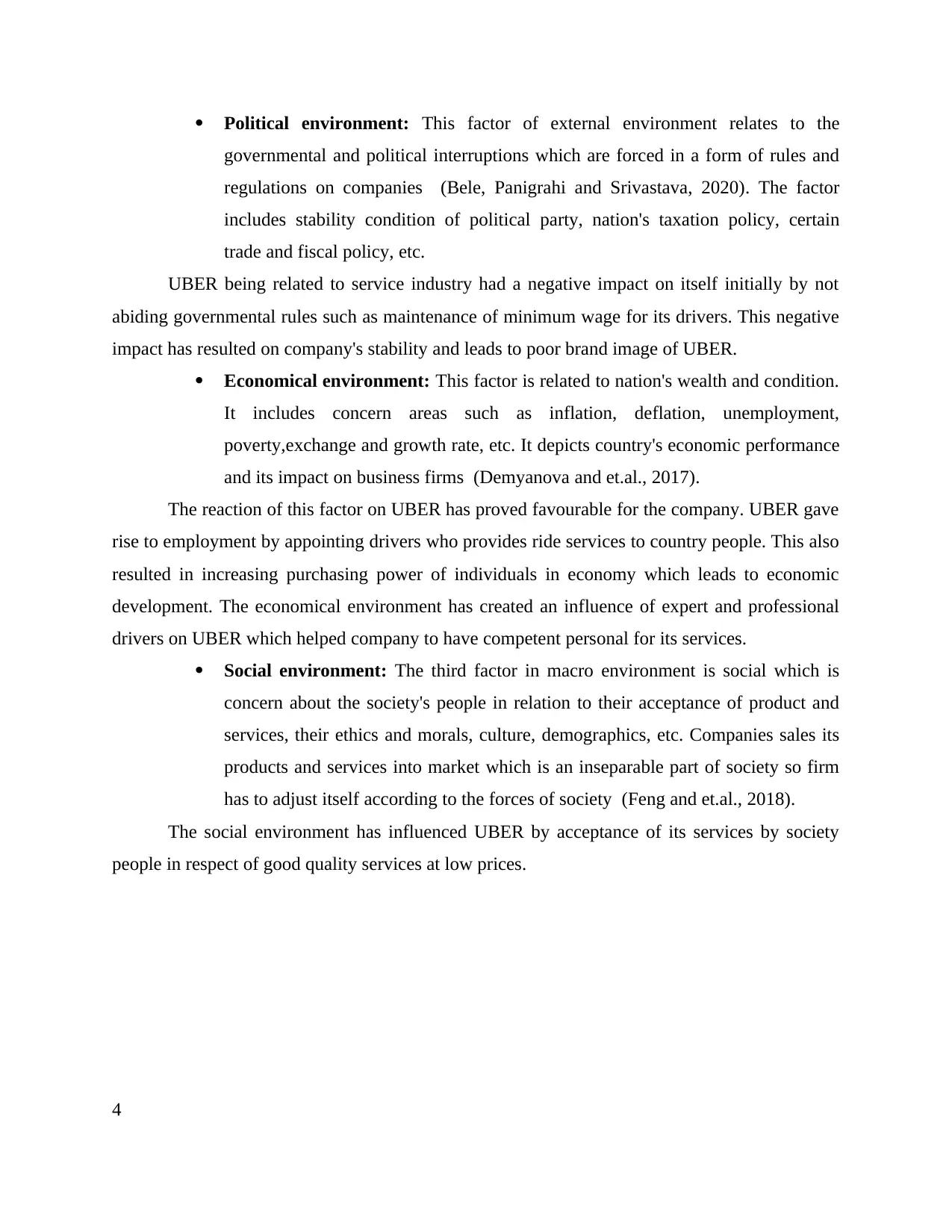
Political environment: This factor of external environment relates to the
governmental and political interruptions which are forced in a form of rules and
regulations on companies (Bele, Panigrahi and Srivastava, 2020). The factor
includes stability condition of political party, nation's taxation policy, certain
trade and fiscal policy, etc.
UBER being related to service industry had a negative impact on itself initially by not
abiding governmental rules such as maintenance of minimum wage for its drivers. This negative
impact has resulted on company's stability and leads to poor brand image of UBER.
Economical environment: This factor is related to nation's wealth and condition.
It includes concern areas such as inflation, deflation, unemployment,
poverty,exchange and growth rate, etc. It depicts country's economic performance
and its impact on business firms (Demyanova and et.al., 2017).
The reaction of this factor on UBER has proved favourable for the company. UBER gave
rise to employment by appointing drivers who provides ride services to country people. This also
resulted in increasing purchasing power of individuals in economy which leads to economic
development. The economical environment has created an influence of expert and professional
drivers on UBER which helped company to have competent personal for its services.
Social environment: The third factor in macro environment is social which is
concern about the society's people in relation to their acceptance of product and
services, their ethics and morals, culture, demographics, etc. Companies sales its
products and services into market which is an inseparable part of society so firm
has to adjust itself according to the forces of society (Feng and et.al., 2018).
The social environment has influenced UBER by acceptance of its services by society
people in respect of good quality services at low prices.
4
governmental and political interruptions which are forced in a form of rules and
regulations on companies (Bele, Panigrahi and Srivastava, 2020). The factor
includes stability condition of political party, nation's taxation policy, certain
trade and fiscal policy, etc.
UBER being related to service industry had a negative impact on itself initially by not
abiding governmental rules such as maintenance of minimum wage for its drivers. This negative
impact has resulted on company's stability and leads to poor brand image of UBER.
Economical environment: This factor is related to nation's wealth and condition.
It includes concern areas such as inflation, deflation, unemployment,
poverty,exchange and growth rate, etc. It depicts country's economic performance
and its impact on business firms (Demyanova and et.al., 2017).
The reaction of this factor on UBER has proved favourable for the company. UBER gave
rise to employment by appointing drivers who provides ride services to country people. This also
resulted in increasing purchasing power of individuals in economy which leads to economic
development. The economical environment has created an influence of expert and professional
drivers on UBER which helped company to have competent personal for its services.
Social environment: The third factor in macro environment is social which is
concern about the society's people in relation to their acceptance of product and
services, their ethics and morals, culture, demographics, etc. Companies sales its
products and services into market which is an inseparable part of society so firm
has to adjust itself according to the forces of society (Feng and et.al., 2018).
The social environment has influenced UBER by acceptance of its services by society
people in respect of good quality services at low prices.
4
Paraphrase This Document
Need a fresh take? Get an instant paraphrase of this document with our AI Paraphraser
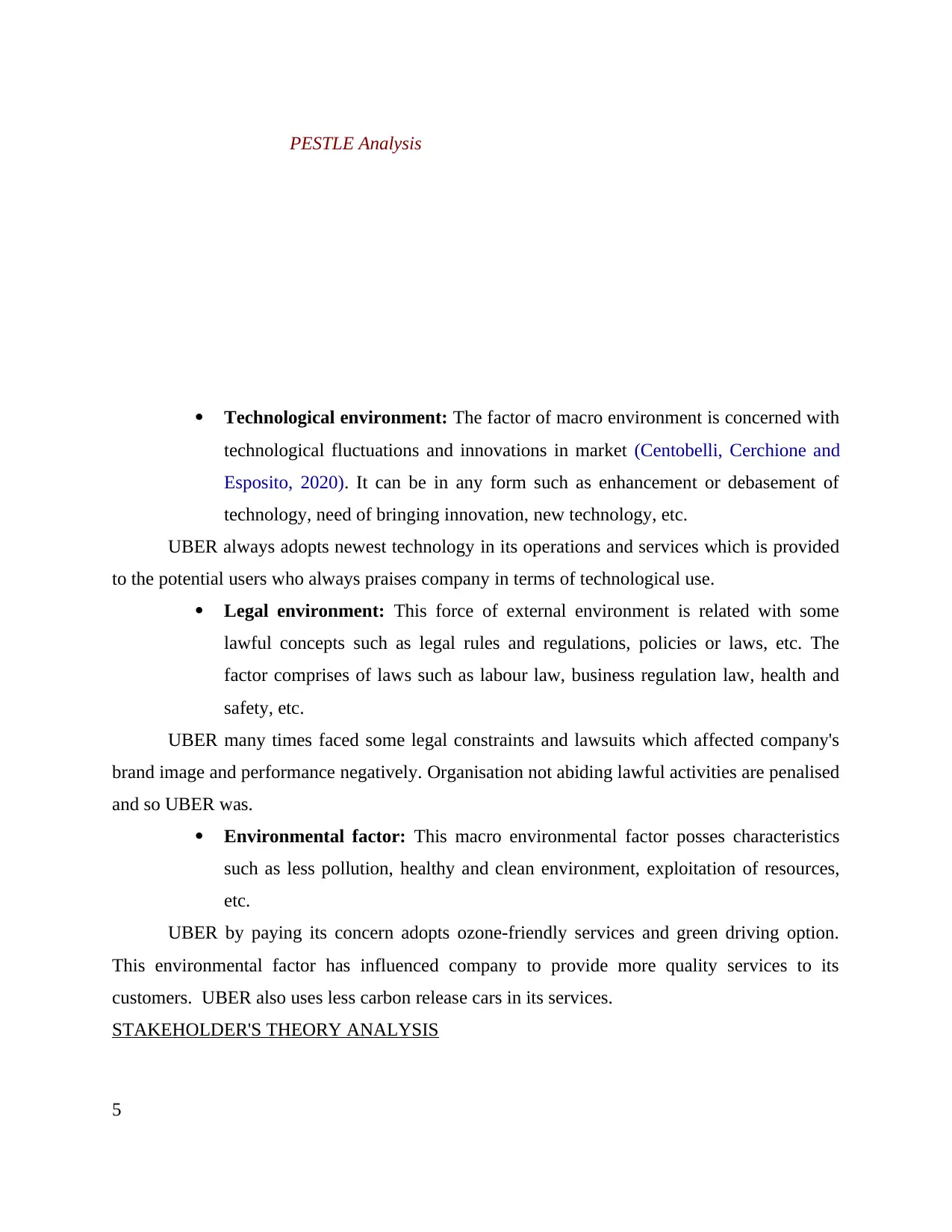
Technological environment: The factor of macro environment is concerned with
technological fluctuations and innovations in market (Centobelli, Cerchione and
Esposito, 2020). It can be in any form such as enhancement or debasement of
technology, need of bringing innovation, new technology, etc.
UBER always adopts newest technology in its operations and services which is provided
to the potential users who always praises company in terms of technological use.
Legal environment: This force of external environment is related with some
lawful concepts such as legal rules and regulations, policies or laws, etc. The
factor comprises of laws such as labour law, business regulation law, health and
safety, etc.
UBER many times faced some legal constraints and lawsuits which affected company's
brand image and performance negatively. Organisation not abiding lawful activities are penalised
and so UBER was.
Environmental factor: This macro environmental factor posses characteristics
such as less pollution, healthy and clean environment, exploitation of resources,
etc.
UBER by paying its concern adopts ozone-friendly services and green driving option.
This environmental factor has influenced company to provide more quality services to its
customers. UBER also uses less carbon release cars in its services.
STAKEHOLDER'S THEORY ANALYSIS
5
PESTLE Analysis
technological fluctuations and innovations in market (Centobelli, Cerchione and
Esposito, 2020). It can be in any form such as enhancement or debasement of
technology, need of bringing innovation, new technology, etc.
UBER always adopts newest technology in its operations and services which is provided
to the potential users who always praises company in terms of technological use.
Legal environment: This force of external environment is related with some
lawful concepts such as legal rules and regulations, policies or laws, etc. The
factor comprises of laws such as labour law, business regulation law, health and
safety, etc.
UBER many times faced some legal constraints and lawsuits which affected company's
brand image and performance negatively. Organisation not abiding lawful activities are penalised
and so UBER was.
Environmental factor: This macro environmental factor posses characteristics
such as less pollution, healthy and clean environment, exploitation of resources,
etc.
UBER by paying its concern adopts ozone-friendly services and green driving option.
This environmental factor has influenced company to provide more quality services to its
customers. UBER also uses less carbon release cars in its services.
STAKEHOLDER'S THEORY ANALYSIS
5
PESTLE Analysis
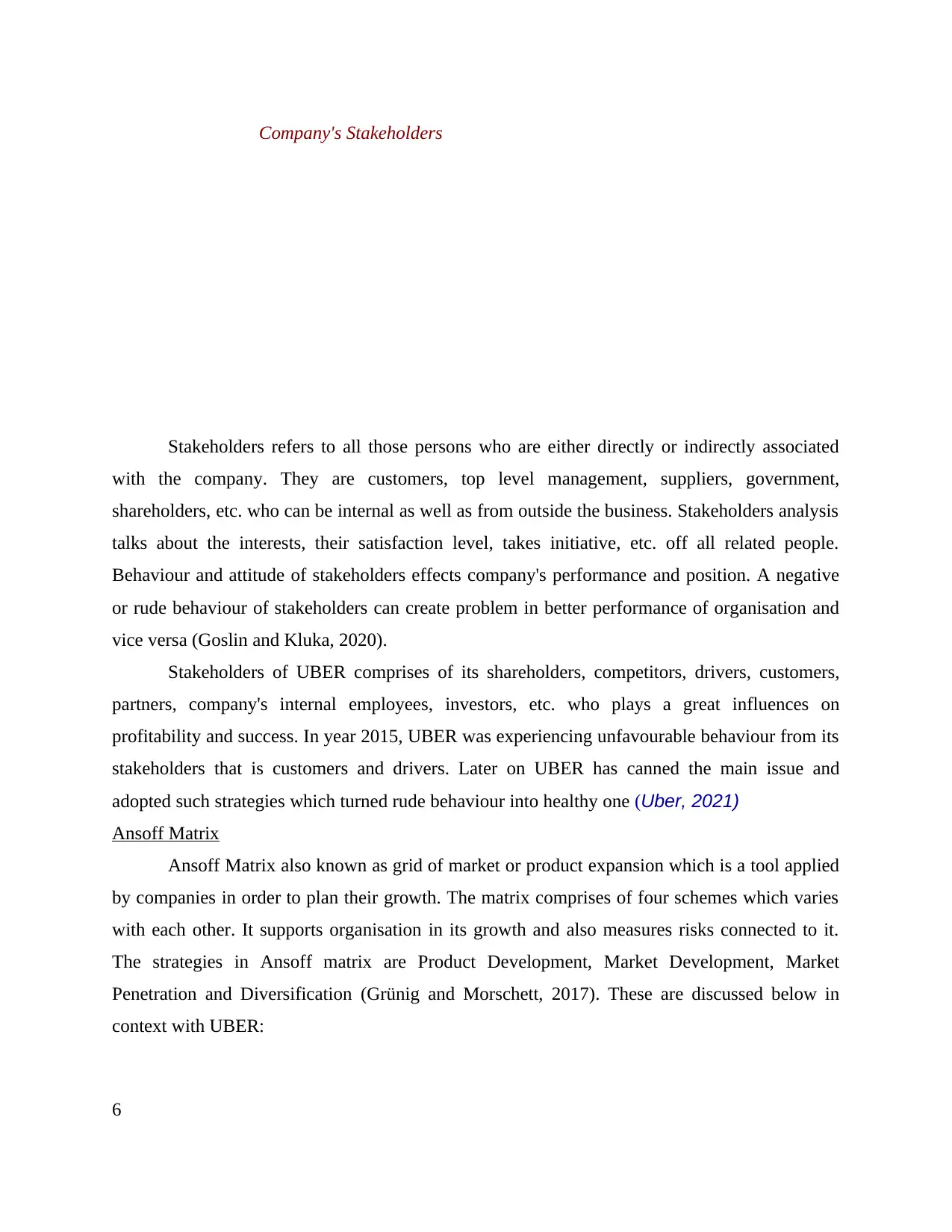
Stakeholders refers to all those persons who are either directly or indirectly associated
with the company. They are customers, top level management, suppliers, government,
shareholders, etc. who can be internal as well as from outside the business. Stakeholders analysis
talks about the interests, their satisfaction level, takes initiative, etc. off all related people.
Behaviour and attitude of stakeholders effects company's performance and position. A negative
or rude behaviour of stakeholders can create problem in better performance of organisation and
vice versa (Goslin and Kluka, 2020).
Stakeholders of UBER comprises of its shareholders, competitors, drivers, customers,
partners, company's internal employees, investors, etc. who plays a great influences on
profitability and success. In year 2015, UBER was experiencing unfavourable behaviour from its
stakeholders that is customers and drivers. Later on UBER has canned the main issue and
adopted such strategies which turned rude behaviour into healthy one (Uber, 2021)
Ansoff Matrix
Ansoff Matrix also known as grid of market or product expansion which is a tool applied
by companies in order to plan their growth. The matrix comprises of four schemes which varies
with each other. It supports organisation in its growth and also measures risks connected to it.
The strategies in Ansoff matrix are Product Development, Market Development, Market
Penetration and Diversification (Grünig and Morschett, 2017). These are discussed below in
context with UBER:
6
Company's Stakeholders
with the company. They are customers, top level management, suppliers, government,
shareholders, etc. who can be internal as well as from outside the business. Stakeholders analysis
talks about the interests, their satisfaction level, takes initiative, etc. off all related people.
Behaviour and attitude of stakeholders effects company's performance and position. A negative
or rude behaviour of stakeholders can create problem in better performance of organisation and
vice versa (Goslin and Kluka, 2020).
Stakeholders of UBER comprises of its shareholders, competitors, drivers, customers,
partners, company's internal employees, investors, etc. who plays a great influences on
profitability and success. In year 2015, UBER was experiencing unfavourable behaviour from its
stakeholders that is customers and drivers. Later on UBER has canned the main issue and
adopted such strategies which turned rude behaviour into healthy one (Uber, 2021)
Ansoff Matrix
Ansoff Matrix also known as grid of market or product expansion which is a tool applied
by companies in order to plan their growth. The matrix comprises of four schemes which varies
with each other. It supports organisation in its growth and also measures risks connected to it.
The strategies in Ansoff matrix are Product Development, Market Development, Market
Penetration and Diversification (Grünig and Morschett, 2017). These are discussed below in
context with UBER:
6
Company's Stakeholders
⊘ This is a preview!⊘
Do you want full access?
Subscribe today to unlock all pages.

Trusted by 1+ million students worldwide

Product Development: This involves some modification or development in company's
current offerings. This can also be done by bringing new product or service into existing
operating market (Hanna, 2019).
UBER applies this by offering international transportation technology and raising its
services regularly. UBER offers a special service named UBER BLACK to its customers which
provides luxury car of black colour to its users.
Market Development: This involves development of market that is launching company's
current products and services into new market. This is a market expansion strategy which
is adopted by company when plans to enter into non-operative market (Hermina,
Roespinoedji and Mohd Saudi, 2020).
UBER implied market development strategy by launching its services geographically, or
across the globe. When UBER came into the market it only serves in San Francisco but company
further expanded its business into markets of India, China, Brazil, US, and Mexico.
Market Penetration: This strategy involves selling of company's current offering into its
existing market. Firms do this either by reducing its product's prices or increasing its
distribution channel or advertisement in the market (Kang and Oh, 2020).
UBER has applied this concept into its business by using different techniques for
promotion of company's sales, and also by lowering down its ride prices as compared to its
rivalries.
7
Ansoff Matrix
current offerings. This can also be done by bringing new product or service into existing
operating market (Hanna, 2019).
UBER applies this by offering international transportation technology and raising its
services regularly. UBER offers a special service named UBER BLACK to its customers which
provides luxury car of black colour to its users.
Market Development: This involves development of market that is launching company's
current products and services into new market. This is a market expansion strategy which
is adopted by company when plans to enter into non-operative market (Hermina,
Roespinoedji and Mohd Saudi, 2020).
UBER implied market development strategy by launching its services geographically, or
across the globe. When UBER came into the market it only serves in San Francisco but company
further expanded its business into markets of India, China, Brazil, US, and Mexico.
Market Penetration: This strategy involves selling of company's current offering into its
existing market. Firms do this either by reducing its product's prices or increasing its
distribution channel or advertisement in the market (Kang and Oh, 2020).
UBER has applied this concept into its business by using different techniques for
promotion of company's sales, and also by lowering down its ride prices as compared to its
rivalries.
7
Ansoff Matrix
Paraphrase This Document
Need a fresh take? Get an instant paraphrase of this document with our AI Paraphraser
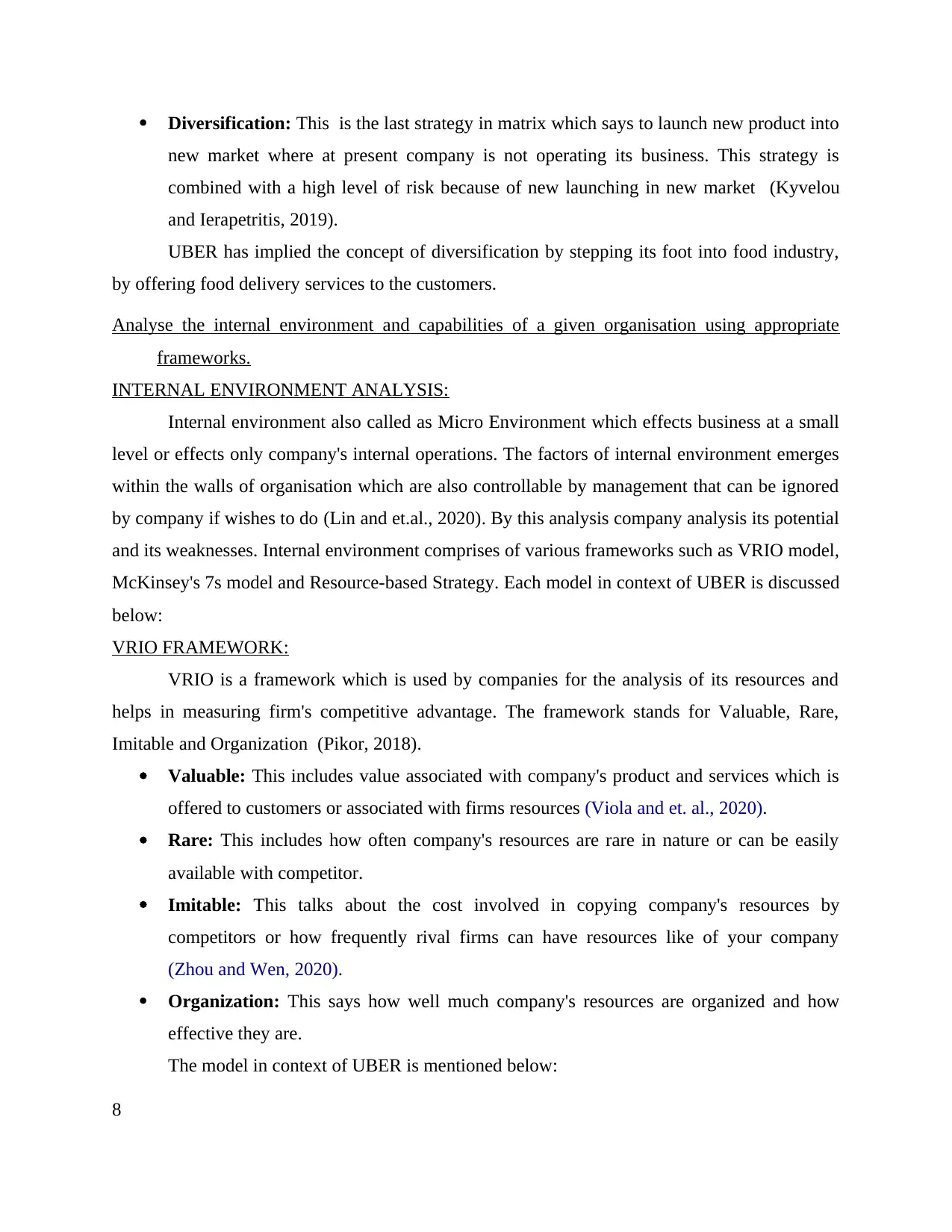
Diversification: This is the last strategy in matrix which says to launch new product into
new market where at present company is not operating its business. This strategy is
combined with a high level of risk because of new launching in new market (Kyvelou
and Ierapetritis, 2019).
UBER has implied the concept of diversification by stepping its foot into food industry,
by offering food delivery services to the customers.
Analyse the internal environment and capabilities of a given organisation using appropriate
frameworks.
INTERNAL ENVIRONMENT ANALYSIS:
Internal environment also called as Micro Environment which effects business at a small
level or effects only company's internal operations. The factors of internal environment emerges
within the walls of organisation which are also controllable by management that can be ignored
by company if wishes to do (Lin and et.al., 2020). By this analysis company analysis its potential
and its weaknesses. Internal environment comprises of various frameworks such as VRIO model,
McKinsey's 7s model and Resource-based Strategy. Each model in context of UBER is discussed
below:
VRIO FRAMEWORK:
VRIO is a framework which is used by companies for the analysis of its resources and
helps in measuring firm's competitive advantage. The framework stands for Valuable, Rare,
Imitable and Organization (Pikor, 2018).
Valuable: This includes value associated with company's product and services which is
offered to customers or associated with firms resources (Viola and et. al., 2020).
Rare: This includes how often company's resources are rare in nature or can be easily
available with competitor.
Imitable: This talks about the cost involved in copying company's resources by
competitors or how frequently rival firms can have resources like of your company
(Zhou and Wen, 2020).
Organization: This says how well much company's resources are organized and how
effective they are.
The model in context of UBER is mentioned below:
8
new market where at present company is not operating its business. This strategy is
combined with a high level of risk because of new launching in new market (Kyvelou
and Ierapetritis, 2019).
UBER has implied the concept of diversification by stepping its foot into food industry,
by offering food delivery services to the customers.
Analyse the internal environment and capabilities of a given organisation using appropriate
frameworks.
INTERNAL ENVIRONMENT ANALYSIS:
Internal environment also called as Micro Environment which effects business at a small
level or effects only company's internal operations. The factors of internal environment emerges
within the walls of organisation which are also controllable by management that can be ignored
by company if wishes to do (Lin and et.al., 2020). By this analysis company analysis its potential
and its weaknesses. Internal environment comprises of various frameworks such as VRIO model,
McKinsey's 7s model and Resource-based Strategy. Each model in context of UBER is discussed
below:
VRIO FRAMEWORK:
VRIO is a framework which is used by companies for the analysis of its resources and
helps in measuring firm's competitive advantage. The framework stands for Valuable, Rare,
Imitable and Organization (Pikor, 2018).
Valuable: This includes value associated with company's product and services which is
offered to customers or associated with firms resources (Viola and et. al., 2020).
Rare: This includes how often company's resources are rare in nature or can be easily
available with competitor.
Imitable: This talks about the cost involved in copying company's resources by
competitors or how frequently rival firms can have resources like of your company
(Zhou and Wen, 2020).
Organization: This says how well much company's resources are organized and how
effective they are.
The model in context of UBER is mentioned below:
8

RESOURCES VALUABLE RARE IMITABLE ORGANIZE COMPETITIVE
ADVANTAGE
Innovation √ x √ √ Temporary Competitive
advantage
High Customer
Rating
√ √ √ √ Sustainable Competitive
advantage
Service Quality √ X √ √ Competitive Parity
Brand
Awareness
√ √ X √ Sustainable competitive
advantage
Financial
condition
√ √ X √ Sustainable Competitive
advantage
UBER's VRIO analysis, 2021
From the VRIO table of UBER it is analysed that:
Valuable: For UBER all of its resources such as Innovation, Customer rating, quality,
brand awareness, financial conditions, etc. are very much valuable and respectable. These
resources provides an competitive advantage to the firm.
Rare: Customer rating, company's brand image and its financial conditions are very
much rare for UBER which could not be easily available for any company whereas
innovation and service quality can be easily available with any company. Resources
which are rare for the company provides sustainable competitive advantage.
Imitable: All of the UBER's resources except company's brand image and financial
condition are imitable in nature.
Organization: UBER very well organizes its resources in the company which are used
very effectively.
MCKINSEY'S 7'S MODEL
9
ADVANTAGE
Innovation √ x √ √ Temporary Competitive
advantage
High Customer
Rating
√ √ √ √ Sustainable Competitive
advantage
Service Quality √ X √ √ Competitive Parity
Brand
Awareness
√ √ X √ Sustainable competitive
advantage
Financial
condition
√ √ X √ Sustainable Competitive
advantage
UBER's VRIO analysis, 2021
From the VRIO table of UBER it is analysed that:
Valuable: For UBER all of its resources such as Innovation, Customer rating, quality,
brand awareness, financial conditions, etc. are very much valuable and respectable. These
resources provides an competitive advantage to the firm.
Rare: Customer rating, company's brand image and its financial conditions are very
much rare for UBER which could not be easily available for any company whereas
innovation and service quality can be easily available with any company. Resources
which are rare for the company provides sustainable competitive advantage.
Imitable: All of the UBER's resources except company's brand image and financial
condition are imitable in nature.
Organization: UBER very well organizes its resources in the company which are used
very effectively.
MCKINSEY'S 7'S MODEL
9
⊘ This is a preview!⊘
Do you want full access?
Subscribe today to unlock all pages.

Trusted by 1+ million students worldwide
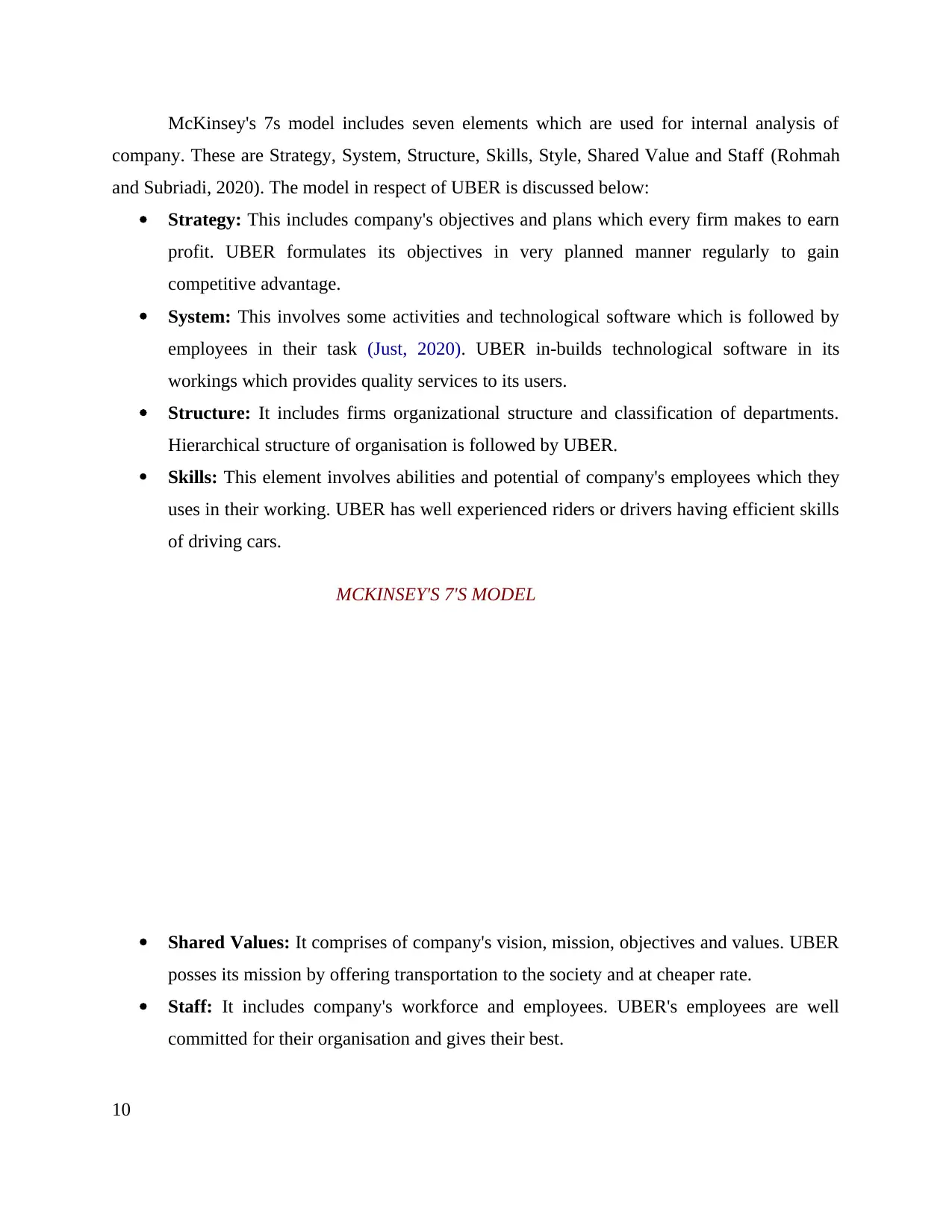
McKinsey's 7s model includes seven elements which are used for internal analysis of
company. These are Strategy, System, Structure, Skills, Style, Shared Value and Staff (Rohmah
and Subriadi, 2020). The model in respect of UBER is discussed below:
Strategy: This includes company's objectives and plans which every firm makes to earn
profit. UBER formulates its objectives in very planned manner regularly to gain
competitive advantage.
System: This involves some activities and technological software which is followed by
employees in their task (Just, 2020). UBER in-builds technological software in its
workings which provides quality services to its users.
Structure: It includes firms organizational structure and classification of departments.
Hierarchical structure of organisation is followed by UBER.
Skills: This element involves abilities and potential of company's employees which they
uses in their working. UBER has well experienced riders or drivers having efficient skills
of driving cars.
Shared Values: It comprises of company's vision, mission, objectives and values. UBER
posses its mission by offering transportation to the society and at cheaper rate.
Staff: It includes company's workforce and employees. UBER's employees are well
committed for their organisation and gives their best.
10
MCKINSEY'S 7'S MODEL
company. These are Strategy, System, Structure, Skills, Style, Shared Value and Staff (Rohmah
and Subriadi, 2020). The model in respect of UBER is discussed below:
Strategy: This includes company's objectives and plans which every firm makes to earn
profit. UBER formulates its objectives in very planned manner regularly to gain
competitive advantage.
System: This involves some activities and technological software which is followed by
employees in their task (Just, 2020). UBER in-builds technological software in its
workings which provides quality services to its users.
Structure: It includes firms organizational structure and classification of departments.
Hierarchical structure of organisation is followed by UBER.
Skills: This element involves abilities and potential of company's employees which they
uses in their working. UBER has well experienced riders or drivers having efficient skills
of driving cars.
Shared Values: It comprises of company's vision, mission, objectives and values. UBER
posses its mission by offering transportation to the society and at cheaper rate.
Staff: It includes company's workforce and employees. UBER's employees are well
committed for their organisation and gives their best.
10
MCKINSEY'S 7'S MODEL
Paraphrase This Document
Need a fresh take? Get an instant paraphrase of this document with our AI Paraphraser
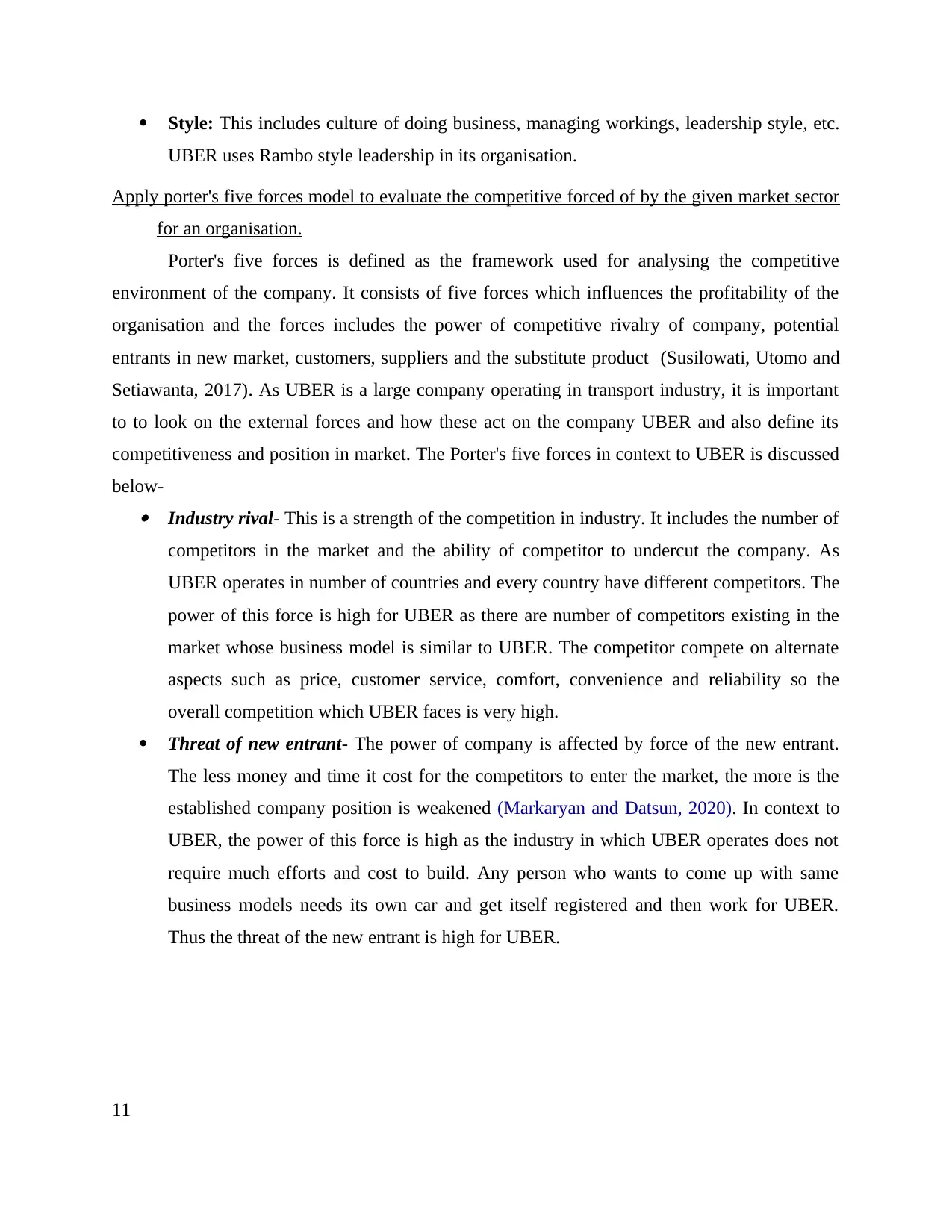
Style: This includes culture of doing business, managing workings, leadership style, etc.
UBER uses Rambo style leadership in its organisation.
Apply porter's five forces model to evaluate the competitive forced of by the given market sector
for an organisation.
Porter's five forces is defined as the framework used for analysing the competitive
environment of the company. It consists of five forces which influences the profitability of the
organisation and the forces includes the power of competitive rivalry of company, potential
entrants in new market, customers, suppliers and the substitute product (Susilowati, Utomo and
Setiawanta, 2017). As UBER is a large company operating in transport industry, it is important
to to look on the external forces and how these act on the company UBER and also define its
competitiveness and position in market. The Porter's five forces in context to UBER is discussed
below- Industry rival- This is a strength of the competition in industry. It includes the number of
competitors in the market and the ability of competitor to undercut the company. As
UBER operates in number of countries and every country have different competitors. The
power of this force is high for UBER as there are number of competitors existing in the
market whose business model is similar to UBER. The competitor compete on alternate
aspects such as price, customer service, comfort, convenience and reliability so the
overall competition which UBER faces is very high.
Threat of new entrant- The power of company is affected by force of the new entrant.
The less money and time it cost for the competitors to enter the market, the more is the
established company position is weakened (Markaryan and Datsun, 2020). In context to
UBER, the power of this force is high as the industry in which UBER operates does not
require much efforts and cost to build. Any person who wants to come up with same
business models needs its own car and get itself registered and then work for UBER.
Thus the threat of the new entrant is high for UBER.
11
UBER uses Rambo style leadership in its organisation.
Apply porter's five forces model to evaluate the competitive forced of by the given market sector
for an organisation.
Porter's five forces is defined as the framework used for analysing the competitive
environment of the company. It consists of five forces which influences the profitability of the
organisation and the forces includes the power of competitive rivalry of company, potential
entrants in new market, customers, suppliers and the substitute product (Susilowati, Utomo and
Setiawanta, 2017). As UBER is a large company operating in transport industry, it is important
to to look on the external forces and how these act on the company UBER and also define its
competitiveness and position in market. The Porter's five forces in context to UBER is discussed
below- Industry rival- This is a strength of the competition in industry. It includes the number of
competitors in the market and the ability of competitor to undercut the company. As
UBER operates in number of countries and every country have different competitors. The
power of this force is high for UBER as there are number of competitors existing in the
market whose business model is similar to UBER. The competitor compete on alternate
aspects such as price, customer service, comfort, convenience and reliability so the
overall competition which UBER faces is very high.
Threat of new entrant- The power of company is affected by force of the new entrant.
The less money and time it cost for the competitors to enter the market, the more is the
established company position is weakened (Markaryan and Datsun, 2020). In context to
UBER, the power of this force is high as the industry in which UBER operates does not
require much efforts and cost to build. Any person who wants to come up with same
business models needs its own car and get itself registered and then work for UBER.
Thus the threat of the new entrant is high for UBER.
11
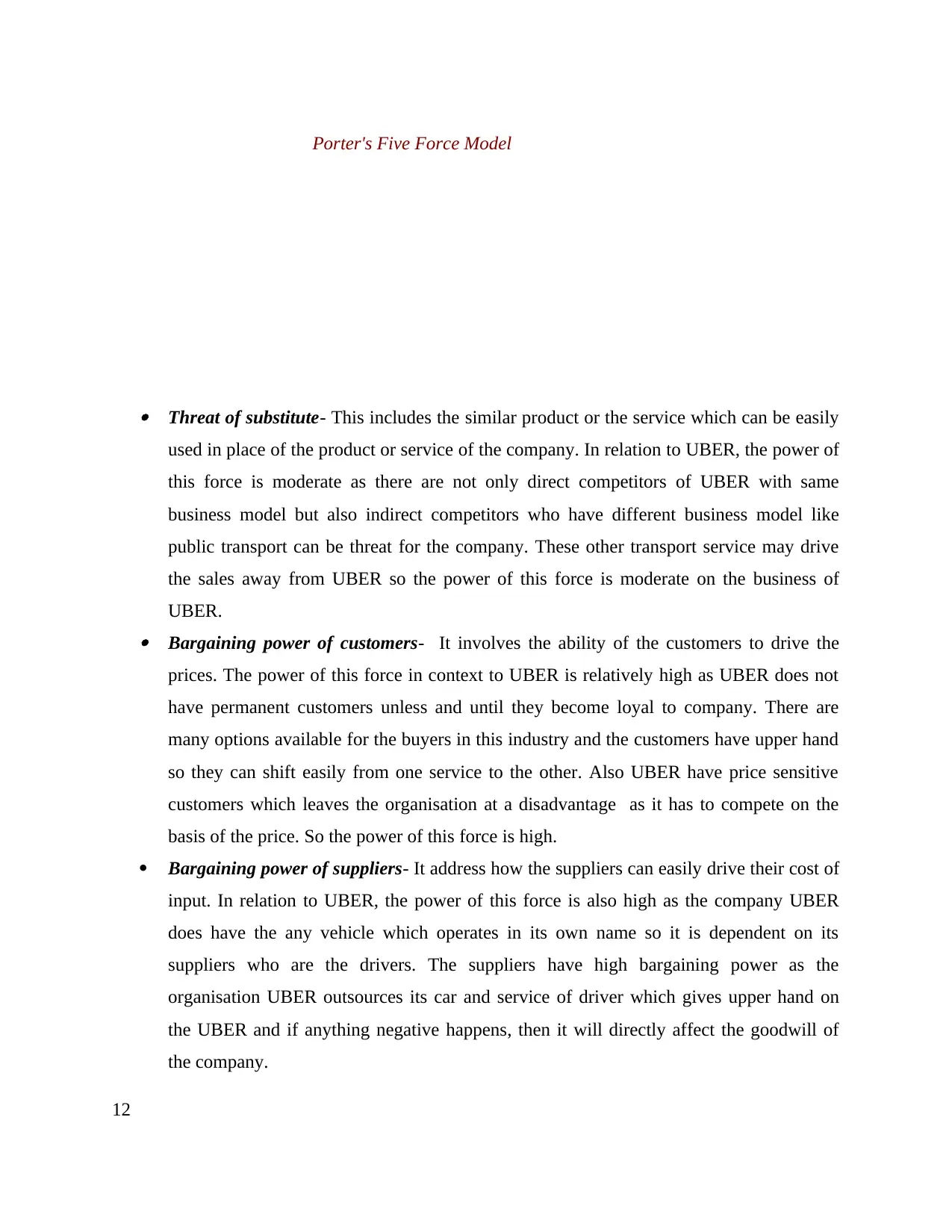
Threat of substitute- This includes the similar product or the service which can be easily
used in place of the product or service of the company. In relation to UBER, the power of
this force is moderate as there are not only direct competitors of UBER with same
business model but also indirect competitors who have different business model like
public transport can be threat for the company. These other transport service may drive
the sales away from UBER so the power of this force is moderate on the business of
UBER. Bargaining power of customers- It involves the ability of the customers to drive the
prices. The power of this force in context to UBER is relatively high as UBER does not
have permanent customers unless and until they become loyal to company. There are
many options available for the buyers in this industry and the customers have upper hand
so they can shift easily from one service to the other. Also UBER have price sensitive
customers which leaves the organisation at a disadvantage as it has to compete on the
basis of the price. So the power of this force is high.
Bargaining power of suppliers- It address how the suppliers can easily drive their cost of
input. In relation to UBER, the power of this force is also high as the company UBER
does have the any vehicle which operates in its own name so it is dependent on its
suppliers who are the drivers. The suppliers have high bargaining power as the
organisation UBER outsources its car and service of driver which gives upper hand on
the UBER and if anything negative happens, then it will directly affect the goodwill of
the company.
12
Porter's Five Force Model
used in place of the product or service of the company. In relation to UBER, the power of
this force is moderate as there are not only direct competitors of UBER with same
business model but also indirect competitors who have different business model like
public transport can be threat for the company. These other transport service may drive
the sales away from UBER so the power of this force is moderate on the business of
UBER. Bargaining power of customers- It involves the ability of the customers to drive the
prices. The power of this force in context to UBER is relatively high as UBER does not
have permanent customers unless and until they become loyal to company. There are
many options available for the buyers in this industry and the customers have upper hand
so they can shift easily from one service to the other. Also UBER have price sensitive
customers which leaves the organisation at a disadvantage as it has to compete on the
basis of the price. So the power of this force is high.
Bargaining power of suppliers- It address how the suppliers can easily drive their cost of
input. In relation to UBER, the power of this force is also high as the company UBER
does have the any vehicle which operates in its own name so it is dependent on its
suppliers who are the drivers. The suppliers have high bargaining power as the
organisation UBER outsources its car and service of driver which gives upper hand on
the UBER and if anything negative happens, then it will directly affect the goodwill of
the company.
12
Porter's Five Force Model
⊘ This is a preview!⊘
Do you want full access?
Subscribe today to unlock all pages.

Trusted by 1+ million students worldwide
1 out of 20
Related Documents
Your All-in-One AI-Powered Toolkit for Academic Success.
+13062052269
info@desklib.com
Available 24*7 on WhatsApp / Email
![[object Object]](/_next/static/media/star-bottom.7253800d.svg)
Unlock your academic potential
Copyright © 2020–2025 A2Z Services. All Rights Reserved. Developed and managed by ZUCOL.





